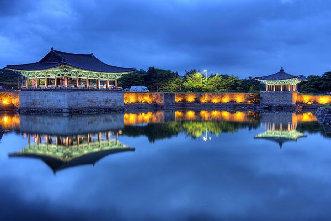Anapji Pond - Artificial Pond Built in 674
Anapji Pond is an artificial pond in Gyeongju National Park, Gyeongju, South Korea and plays a part of South Korea history.
Anapji means "Goose and Duck Lake".
The pond is situated at the northest edge of the Banwolseong palace site in central Gyeongju and it contains three small islands. It was part of the palace complex of ancient Silla (57 BCE - 935 CE).
It was originally constructed in Febuary in 674 during the reign og Munmu, the 30th King of Silla.
Munmu was the deserving seccessor of a dynasty with an illustrative history bearing the legacy of his royal family in an impressive fashion. His father, King Muyeol, unified the Korean peninsula in 668, masterminding the defeat of the Baekje and Goguryeo Kingdoms which fell in 660 and 668 respectively.

Today's Anapji Pond in South Korea is a mere echo of its original form with very little of the vegetation remaining and none of the original architecture existing.
During Munmu's time, Anapji served as a resort garden verdant with rare plants and teeming with animals.
To impress the Tang Dynasty Chinese envoys, miniature models of the twelve famous peaks of China's Wushan Mountain were terraced around the lake. Envoys could relax in an atmosphere inspired by the scenery of their homeland.
Anapji Pond Back to Historic Sites





